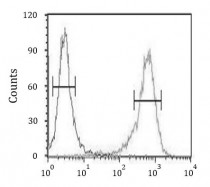ARG58285
anti-ATP2A1 / SERCA1 ATPase (isoform b) antibody
anti-ATP2A1 / SERCA1 ATPase (isoform b) antibody for Flow cytometry,IHC-Formalin-fixed paraffin-embedded sections,Western blot and Human
Overview
| Product Description | Rabbit Polyclonal antibody recognizes ATP2A1 / SERCA1 ATPase (isoform b) |
|---|---|
| Tested Reactivity | Hu |
| Predict Reactivity | Rb |
| Tested Application | FACS, IHC-P, WB |
| Host | Rabbit |
| Clonality | Polyclonal |
| Isotype | IgG |
| Target Name | ATP2A1 / SERCA1 ATPase (isoform b) |
| Antigen Species | Human |
| Immunogen | KLH-conjugated synthetic peptide corresponding to aa. 974-1001 of Human ATP2A1 / SERCA1 ATPase (isoform b). |
| Conjugation | Un-conjugated |
| Alternate Names | SERCA1; ATP2A; SR Ca; Endoplasmic reticulum class 1/2 Ca; EC 3.6.3.8; Sarcoplasmic/endoplasmic reticulum calcium ATPase 1; Calcium pump 1; Calcium-transporting ATPase sarcoplasmic reticulum type, fast twitch skeletal muscle isoform; 2+ |
Application Instructions
| Application Suggestion |
|
||||||||
|---|---|---|---|---|---|---|---|---|---|
| Application Note | * The dilutions indicate recommended starting dilutions and the optimal dilutions or concentrations should be determined by the scientist. | ||||||||
| Positive Control | HT1080 |
Properties
| Form | Liquid |
|---|---|
| Purification | Purification with Protein A and immunogen peptide. |
| Buffer | PBS and 0.09% (W/V) Sodium azide. |
| Preservative | 0.09% (W/V) Sodium azide. |
| Storage Instruction | For continuous use, store undiluted antibody at 2-8°C for up to a week. For long-term storage, aliquot and store at -20°C or below. Storage in frost free freezers is not recommended. Avoid repeated freeze/thaw cycles. Suggest spin the vial prior to opening. The antibody solution should be gently mixed before use. |
| Note | For laboratory research only, not for drug, diagnostic or other use. |
Bioinformation
| Database Links |
Swiss-port # O14983 Human Sarcoplasmic/endoplasmic reticulum calcium ATPase 1 |
|---|---|
| Gene Symbol | ATP2A1 |
| Gene Full Name | ATPase, Ca++ transporting, cardiac muscle, fast twitch 1 |
| Background | This gene encodes one of the SERCA Ca(2+)-ATPases, which are intracellular pumps located in the sarcoplasmic or endoplasmic reticula of muscle cells. This enzyme catalyzes the hydrolysis of ATP coupled with the translocation of calcium from the cytosol to the sarcoplasmic reticulum lumen, and is involved in muscular excitation and contraction. Mutations in this gene cause some autosomal recessive forms of Brody disease, characterized by increasing impairment of muscular relaxation during exercise. Alternative splicing results in three transcript variants encoding different isoforms. [provided by RefSeq, Oct 2013] |
| Function | Key regulator of striated muscle performance by acting as the major Ca(2+) ATPase responsible for the reuptake of cytosolic Ca(2+) into the sarcoplasmic reticulum. Catalyzes the hydrolysis of ATP coupled with the translocation of calcium from the cytosol to the sarcoplasmic reticulum lumen. Contributes to calcium sequestration involved in muscular excitation/contraction. [UniProt] |
| Cellular Localization | Endoplasmic reticulum membrane; Multi-pass membrane protein. Sarcoplasmic reticulum membrane; Multi-pass membrane protein. [UniProt] |
| Calculated MW | 110 kDa |
Images (3) Click the Picture to Zoom In
-
ARG58285 anti-ATP2A1 / SERCA1 ATPase (isoform b) antibody IHC-P image
Immunohistochemistry: Formalin-fixed and paraffin-embedded Human skeletal muscle stained with ARG58285 anti-ATP2A1 / SERCA1 ATPase (isoform b) antibody.
-
ARG58285 anti-ATP2A1 / SERCA1 ATPase (isoform b) antibody WB image
Western blot: 35 µg of HT1080 cell lysate stained with ARG58285 anti-ATP2A1 / SERCA1 ATPase (isoform b) antibody at 1:1000 dilution.
-
ARG58285 anti-ATP2A1 / SERCA1 ATPase (isoform b) antibody FACS image
Flow Cytometry: K562 cells stained with ARG58285 anti-ATP2A1 / SERCA1 ATPase (isoform b) antibody (right histogram) or without primary antibody as control (left histogram), followed by incubation with FITC labelled secondary antibody.








